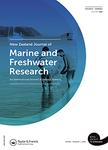版权所有:内蒙古大学图书馆 技术提供:维普资讯• 智图
内蒙古自治区呼和浩特市赛罕区大学西街235号 邮编: 010021

作者机构:New Zealand Oceanographic Institute Department of Scientific and Industrial Research Wellington New Zealand
出 版 物:《New Zealand Journal of Marine and Freshwater Research》 (New Zealand J. Mar. Freshw. Res.)
年 卷 期:1974年第8卷第1期
页 面:15-38页
学科分类:0710[理学-生物学] 0830[工学-环境科学与工程(可授工学、理学、农学学位)] 0908[农学-水产] 0707[理学-海洋科学] 08[工学] 081501[工学-水文学及水资源] 0815[工学-水利工程] 0713[理学-生态学]
摘 要:The distributions of two swimming crabs endemic to the New Zealand region are described, mostly from material obtained at 118 of 2544 New Zealand Oceanographic Institute benthic stations *** antarcticus (Jacquinot) was found within the geographic limits 34°S‐51°S and 166° E‐176° W, with concentrations around Cook Strait, the Chatham Rise, Foveaux Strait, and the Auckland Is. N. bennetti (Takeda & Miyake) occurred between 44° S and 53° S, and 165° E and 180°, most frequently in the south and west, on the ‘highs’ of the Campbell Plateau. Although the distributions overlap between 44° S and 51° S, and this overlap zone produced most of the available material, only one joint occurrence of the two species was noted. This apparent separation was not satisfactorily explained by any of the ecological factors recorded. The depth ranges of both species were broadly similar (0–550 m for TV. antarcticus, 20–474 m for JV. bennetti);both were most frequently obtained at depths less than 200 m. Both occurred primarily on the coarser sediment grades, though N. antarcticus occupied a broader range of grades than N. *** size ranges of the two species were similar;carapace lengths were 8.0–62.0 mm for N. antarcticus and 5.8–68.0 mm for N. bennetti. The larger specimens of both species were found towards the southern limits of distribution. Larger specimens of N. antarcticus were absent from depths greater than 120 m;smaller N. antarcticus and all N. bennetti occurred throughout their respective depth ranges. Ovigerous N. antarcticus (smallest, 8.8 mm carapace length) were obtained at depths of 17–263 m from May to October;ovigerous N. bennetti (smallest 36.1 mm) were from depths of 150–183 m in May only. © 1974 Taylor & Francis Group, LLC.